Contemporary test originally published in Road & Track’s Open Road Winter 1998/1999\
Keep the lava field but draw in a chromium bikini-clad warrior woman toting a laser gun set to stun. By all rights, illustrations accompanying this article should not be photographs but cartoons. Not Roger Rabbit, but the futuristic bizarre world of Japanimation. That’s close enough for Isuzu, who is clearly expecting the VehiCross to make shockwaves. “Go Farther,” say Isuzu ads. The VehiCross does exactly that
The VehiCross is quite simply the love child of a sport-utility vehicle and a sports car. It began as he VehiCross concept vehicle shown at the 1993 Tokyo auto show and remains true to the overall appearance of the original but is larger, and instead of a custom aluminum frame, the production VehiCross is built on a two-door [Isuzu] Trooper’s backside. It has the most powerful engine Isuzu puts in a passenger vehicle and comes standard with Isuzu’s Torque-On-Demand 4wd system along with a special sports suspension.
What really sets the VehiCross apart from all the other SUVs is its outrageous body that admittedly some will revile and others will love, but no one will be able to ignore.
Most noticeable, perhaps, is the two-layer style of the two-door SUV. The upper level resembles an automotive sport wagon, sleek with a raked windshield and swoopy aerodynamic headlamps and a fully enclosed “continental kit” spare tire mounted out back. The B-pillar is blacked out to blend in with the small side window ahead of the wide C-pillar for a hardtop look that emphasizes horizontal lines. Trapezoidal rear quarter windows slant forward. It may not be cutting-edge for sports cars, but this definitely isn’t the usual box-on-wheels SUV.
The lower level of the VehiCross body, however, goes a step beyond the usual rugged SUV profile. For “rigidizing” pleats are stamped into the doors and the whole lower third of the vehicle is swathed in charcoal -colored anti-chip polypropylene cladding attached, in part, by genuine Torx screws. They’re not bogus screws molded into the plastic. The cladding is shaped into massive flares and, between the wheel wells is a tall ridge that promises to deflect splash from the front tires. A rear spoiler rides high on the tailgate, and from the front you’ll no doubt recognize the Rocketman in the VehiCross’ face. Stylistically it’s about as far as one can get from Trooper.
The VehiCross, however, doesn’t have nearly the interior of the bigger Trooper. There’s only so much that can be done on a 98.8-in. wheelbase and an overall length that’s a foot shorter than a Honda CR-V. The VehiCross welcomes front-seat passengers with a pair of Recaro buckets upholstered in black leather with red accents. The seats recline, but instead of a release-lever mechanism, the Recaros have a European-style knob to crank the seatback up and down. It’s inconvenient but at least allows the seatback to be set to the precise angle desired. The Recaros live up to their reputation for comfort, side bolsters will prove useful during performance driving. The steering wheel is wrapped in matching leather, with the colors repeated on the door panels. The door panels also have faux carbon-fiber trim inserts, and the gauge faces are textured to resemble carbon fiber as well (leading one to ponder what sort of stresses these items were expected to endure…).
The VehiCross dash is otherwise relatively mundane for a vehicle with such an outrageous exterior, though the center stack includes (as standard equipment) a six-disc CD changer complementing a six-speaker AM/FM/cassette stereo. Active-lifestyle sorts apparently don’t need cupholders for their cappuccino as there’s nothing more than a rectangular depression in the center console that would appear to have a rather low cup-retention rating. The view out the back is limited by the upper contour of the spare-tire carrier, but less so than most with an external carrier. Not available, however, is a rear wiper, though a rear-window defogger is standard.
From the outside it appears that the backseat of the VehiCross, if any, would be small, and despite a slide-forward mechanism on the right front seat, getting in the back is best left to the young and/or limber. Once there, thanks to a rather rearward positioning of the backseat, passengers will find a generous legroom even though head room is short. The headliner, by the way, repeats the corrugations of the outer door panels. If there’s one complaint about rear seat comfort, however, it’s the lack of any opening windows. Even flipper windows would provide some ventilation.
With the rear seat located so far aft there is little room left for cargo, though the rear seatbacks split 50/50 and fold forward. A roof rack is standard and accommodates an accessory bicycle carrier. There is an actual spare tire located in that rear door blister. The mini-spare, mounted on an aluminum wheel, is concealed behind a panel held on by four finger screws. It’s easier to get to than a floor-mounted spare, though the flat won’t fit where the space-saver came from. The rear door is opened only by the ignition key, a minor hassle, as is the “aircraft-style” fuel filler door. It looks the part, and evidently a run-of-the-mill remote release wouldn’t fit the image.
Underneath the zooty image, however, the VehiCross’ drivetrain is identical to the two-door Trooper’s, a vehicle not sold in the U.S. The dohc 3.5-leader V-6, introduce in the Trooper last year, is rated at 215 bhp, with 230 lb-ft of torque at 3000 rpm. It features a variable intake system that boosts torque by altering the length of the intake tract. A valve midway down the tract opens at 3600 rpm, effectively shortening the runner, allowing improved volumetric efficiency and increased torque at higher rpm. The narrow 19 degree valve angle for the 4-valve-per-cylinder power plant reduces the weight of the already lightweight all-aluminum alloy engine while maintaining a fairly direct shot into the combustion chambers.
A 4-speed electronically controlled automatic transmission with “winter” and “sport” shift maps is standard. Isuzu considered a 5-speed manual, as available in the Trooper, but at this time the standard Torque-On-Demand system hasn’t been completely developed for manual-transmission applications. Isuzu decision-makers reasoned that for now the low production volume justified only one transmission, and with the Trooper serving as a technology showcase, the gearbox compatible with TOD—the automatic—gets the nod.
TOD is the only 4-wheel-drive system that “anticipates” the need for a change in torque split rather than waiting for slip to occur. It doesn’t have clairvoyance, but instead utilizes a computer that accepts input from 12 on-board sources to predict whether, through Isuzu’s testing and experimentation under various conditions, tire slip is probable. An electromagnetic wet multi-plate clutch transfers torque from the front wheels (from the continuously connected rear wheels) by increasing pressure on the clutch. TOD in action can be observed most easily by flooring the throttle from rest. The TOD computer calculates that this may cause the rear wheels to spin, so before they do, the TOD system shifts some of the torque to the front wheels – and this can be seen on the TOD graphic on the dash and by a presumable lack of wheel spin. Since there is no way to turn it off, we’ll just have to take Isuzu’s word that TOD makes a difference here. But TOD also allows more slip when making the use of the VehiCross’ small turning ratio, eliminating typical 4wd tire scrub. TOD can vary distribution of drive force to the front wheels from zero to 100 percent, though in low range in mechanical locking clutch replaces the electromagnetic unit.
We don’t have to take it on faith that, unlike most sport-utilities, the VehiCross is fun to drive. Though the engine revs to over six grand, is clearly happier below 4000 rpm or so, which is well enough because that’s where the torque is. Acceleration falls into the “good” range. It won’t frighten any Vette drivers at the stoplight grand prix and there are quicker SUVs, but the VehiCross more than gets out of its own way. Where the VehiCross earns its performance laurels, however, is in handling. The basic Isuzu truck suspension parts are tuned for cornering on paved or loose-surfaced roads. The VehiCross’ 245/70R-16 tires absorb the ripples and stutter bumps of a gravel road and the suspension swallows up potholes and bigger bumps in a way that no sports car ever could, even if one were willing to expose a sports cars delicate lower extremities to the gravel flinging of a dirt road.
In a corner, the VehiCross understeers under a trailing throttle, though with power the front tires go to work and balance the SUV front to rear. The worse the road, the more the VehiCross shines. Even mud puddles a couple of feet deep only slow the VehiCross. Try that and your effete sports car. The VehiCross, however, puts the sport in sport-utility like no other 4-wheeler. And to keep the VehiCross working in the rough stuff, Isuzu equipped it with special remote reservoir shocks front and rear, something seen on competition vehicles but no other production car or truck. The VehiCross, like any SUV worth its mud-and-snow-rated tires, has a dual-range locking transfer case with a suitably low range for picking through the rough stuff.
Yet on pavement, the VehiCross also has a very good ride, albeit firm and sporty. Well, what else would you expect? Probably not the competence in cornering the VehiCross exhibits. The heavy truck tires can be felt through the steering wheel, and the tread can be heard faintly. More noticeable is a gear whine that can be heard when coasting. Of course, neither could be heard if the VehiCross didn’t have such little wind noise. A good sports car will make easy work of the VehiCross on dry pavement – but then there’s all that other stuff the VehiCross will do. On the other hand, Isuzu leaves fitting a winch or brush bars and such to the aftermarket and doesn’t recommend towing. Even the diminutive Kia’s Sportage can pull a personal watercraft trailer.
The VehiCross will probably find few converts from the sports-car crowd, anyway, but it does set up shop as a class of one. No other sport-utility, except perhaps the Chevy Blazer ZR2, is as sporty as the VehiCross, and parked alongside the Isuzu, the Chevy looks positively drab. The VehiCross, already on sale in Japan, will reach dealers in the U.S. in early spring 1999 but only at the rate of about 20 per month. Even at that, we’ll get half of Isuzu’s production. If that doesn’t seem worth doing, consider that the vehicle will serve as a halo vehicle for selling other Isuzus. Though it will get 20 percent of the ad budget, it will constitute only 2 or 3 percent of Isuzu sales. Isuzu is counting on it to add sales by increasing showroom traffic. Be that as it may, the VehiCross opens a new niche in the SUV market and sits astride it as the sole occupant. Go farther? Far out!
Addendum: The original photos in the magazine were by Ron Perry, and we spent a lot of time setting up the shots on a lava field on the big island of Hawaii. Yep, that’s where the press intro of the VehiCross was held. Somebody has to do it. And the photos looked quite dramatic. At least the setting did. I didn’t get to see the final product. For whatever reason, the lava field photo didn’t make the cut. My eloquent prose, however, addressed the original location. “Keep the lava field,” I said. Oops.
After the Hawaii junket, I later had the opportunity to have an VehiCross for a week long sojourn at home. It was great, except the particular model I was provided for testing had“Iron Man” decals on the front fenders, advertising Isuzu’s sponsorship of the grueling athletic event. The problem with that, however, was living up to the Iron Man image. I was in not bad shape, but certainly not an Ironman. Sorry, but if it were my VehiCross, the decals would have to go.







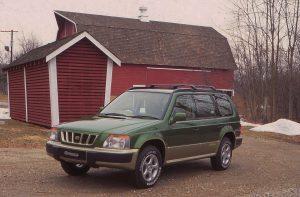
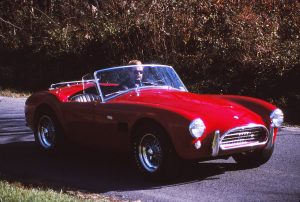

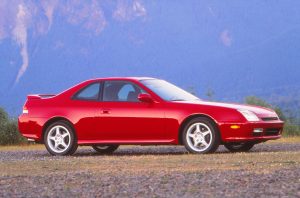

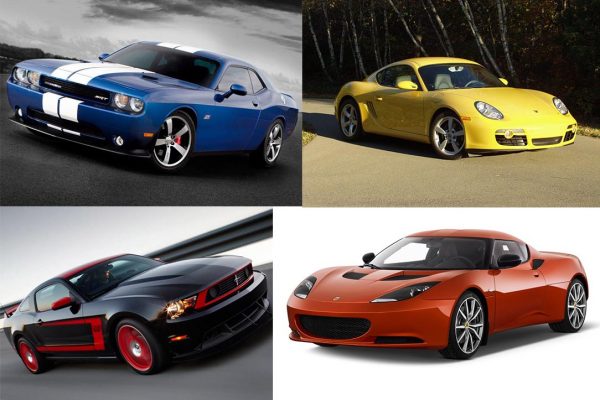
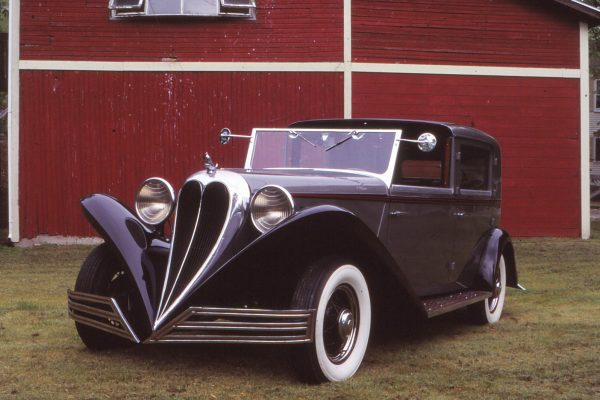
What Do You Think?
You must be logged in to post a comment.